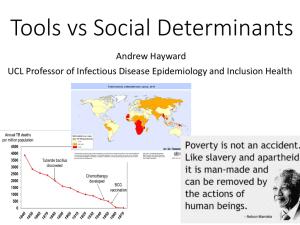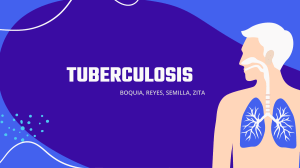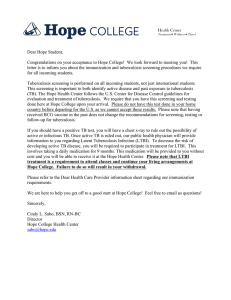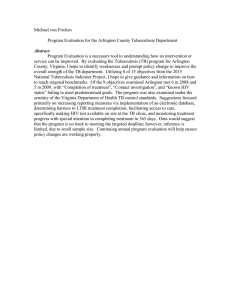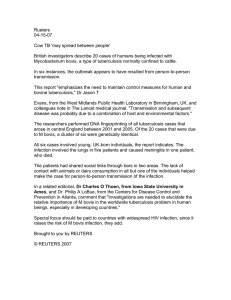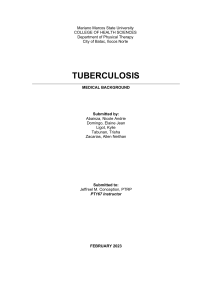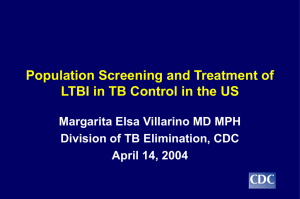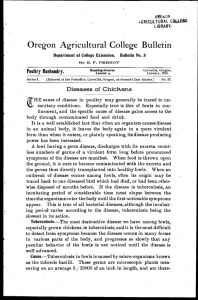TUBERCULOSIS Tuberculosis is a contagious and an often severe airborne disease... INTRODUCTION
advertisement
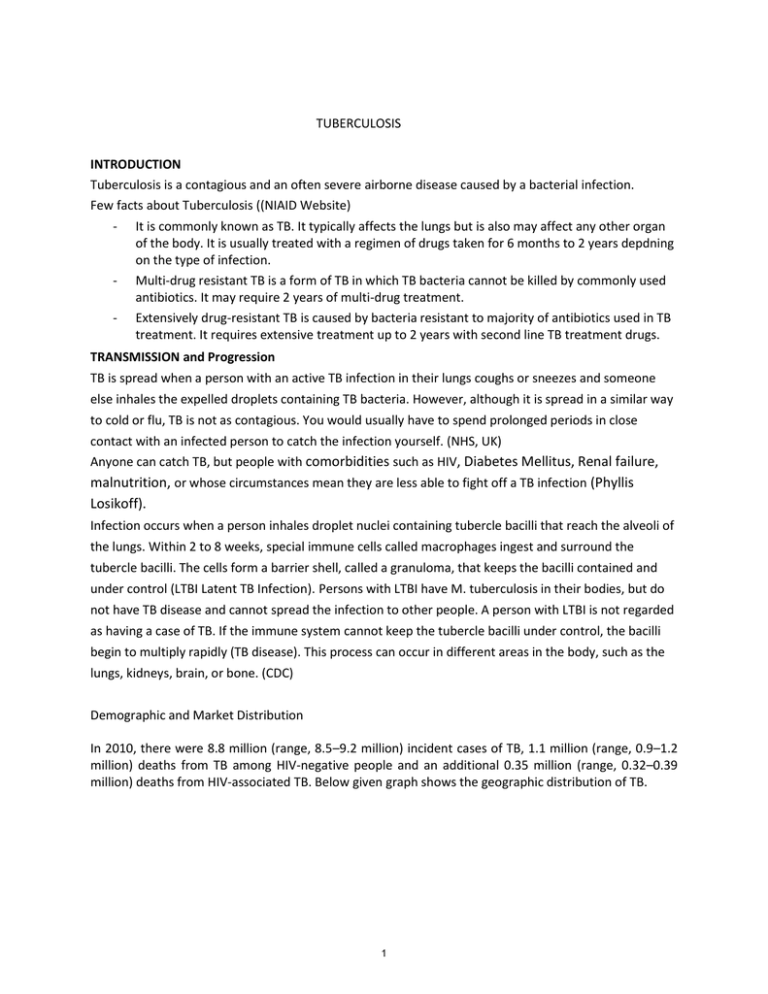
TUBERCULOSIS INTRODUCTION Tuberculosis is a contagious and an often severe airborne disease caused by a bacterial infection. Few facts about Tuberculosis ((NIAID Website) - It is commonly known as TB. It typically affects the lungs but is also may affect any other organ of the body. It is usually treated with a regimen of drugs taken for 6 months to 2 years depdning on the type of infection. - Multi-drug resistant TB is a form of TB in which TB bacteria cannot be killed by commonly used antibiotics. It may require 2 years of multi-drug treatment. - Extensively drug-resistant TB is caused by bacteria resistant to majority of antibiotics used in TB treatment. It requires extensive treatment up to 2 years with second line TB treatment drugs. TRANSMISSION and Progression TB is spread when a person with an active TB infection in their lungs coughs or sneezes and someone else inhales the expelled droplets containing TB bacteria. However, although it is spread in a similar way to cold or flu, TB is not as contagious. You would usually have to spend prolonged periods in close contact with an infected person to catch the infection yourself. (NHS, UK) Anyone can catch TB, but people with comorbidities such as HIV, Diabetes Mellitus, Renal failure, malnutrition, or whose circumstances mean they are less able to fight off a TB infection (Phyllis Losikoff). Infection occurs when a person inhales droplet nuclei containing tubercle bacilli that reach the alveoli of the lungs. Within 2 to 8 weeks, special immune cells called macrophages ingest and surround the tubercle bacilli. The cells form a barrier shell, called a granuloma, that keeps the bacilli contained and under control (LTBI Latent TB Infection). Persons with LTBI have M. tuberculosis in their bodies, but do not have TB disease and cannot spread the infection to other people. A person with LTBI is not regarded as having a case of TB. If the immune system cannot keep the tubercle bacilli under control, the bacilli begin to multiply rapidly (TB disease). This process can occur in different areas in the body, such as the lungs, kidneys, brain, or bone. (CDC) Demographic and Market Distribution In 2010, there were 8.8 million (range, 8.5–9.2 million) incident cases of TB, 1.1 million (range, 0.9–1.2 million) deaths from TB among HIV-negative people and an additional 0.35 million (range, 0.32–0.39 million) deaths from HIV-associated TB. Below given graph shows the geographic distribution of TB. 1 Map removed due to copyright restrictions. See Figure 2.3, Estimated TB incidence rates, 2010 in WHO Report 2011, Global Tuberculosis Control. DIAGNOSIS, TREATMENT AND PREVENTION The symptoms of pulmonary TB include cough, chest pain and hemoptysis; the specific symptoms of extra-pulmonary TB depend on the site of disease. Systemic symptoms of active TB include fever, chills, night sweats, fatigue, loss of appetite and weight loss. Components of a tuberculosis diagnostic work-up include a medical history, physical exam, tuberculin skin test (unless there is a history of a prior positive TST or TB is culture confirmed at time of diagnosis), chest radiograph and bacteriology (Maryland 2007). Long term treatment with antibiotics (Isoniazid/Rifampcin) is given in case of LTBI and few additional antibiotics Timing, costs, and complexity of care delivery. In 97 countries with 92% of the world’s TB cases for which trends can be assessed, funding from domestic and donor sources is expected to amount to US$ 4.4 billion in 2012, up from US$ 3.5 billion in 2006. Most of this funding is being used to support diagnosis and treatment of drug-susceptible TB, although funding for MDR-TB is growing and expected to reach US$ 0.6 billion in 2012. Countries report funding gaps amounting to almost US$ 1 billion in 2012. (WHO 2011). The Healthcare system in developed country is very well which can take care of RB treatment but there is a question mark of healthcare systems in poor countries. Public private mix of Dots implementation. Thus there is a huge opportunity of developing healthcare delivery in developing economies and poor countries (Pubmed). 2 References: 1) NIAID Website: http://www.niaid.nih.gov/topics/tuberculosis/understanding/whatistb/pages/tbdefinitions.aspx 2) NHS, UK: http://www.nhs.uk/Conditions/Tuberculosis/Pages/Causes.aspx 3) Phyllis Losikoff : Comorbidities and Side effects in Tuberculosis case presentations 4) CDC: http://www.cdc.gov/tb/education/corecurr/pdf/chapter2.pdf 5) WHO Report on Global Tuberculosis Control 2011 6) Maryland TB Guidelines for prevention and treatment of Tuberculosis, 2007, http://phpa.dhmh.maryland.gov/OIDPCS/CTBCP/CTBCPDocuments/tbguidelines.pdf 7) Pubmed: http://www.ncbi.nlm.nih.gov/pubmed/12758206 3 MIT OpenCourseWare http://ocw.mit.edu 15.232 Business Model Innovation: Global Health in Frontier Markets Fall 2013 For information about citing these materials or our Terms of Use, visit: http://ocw.mit.edu/terms.
